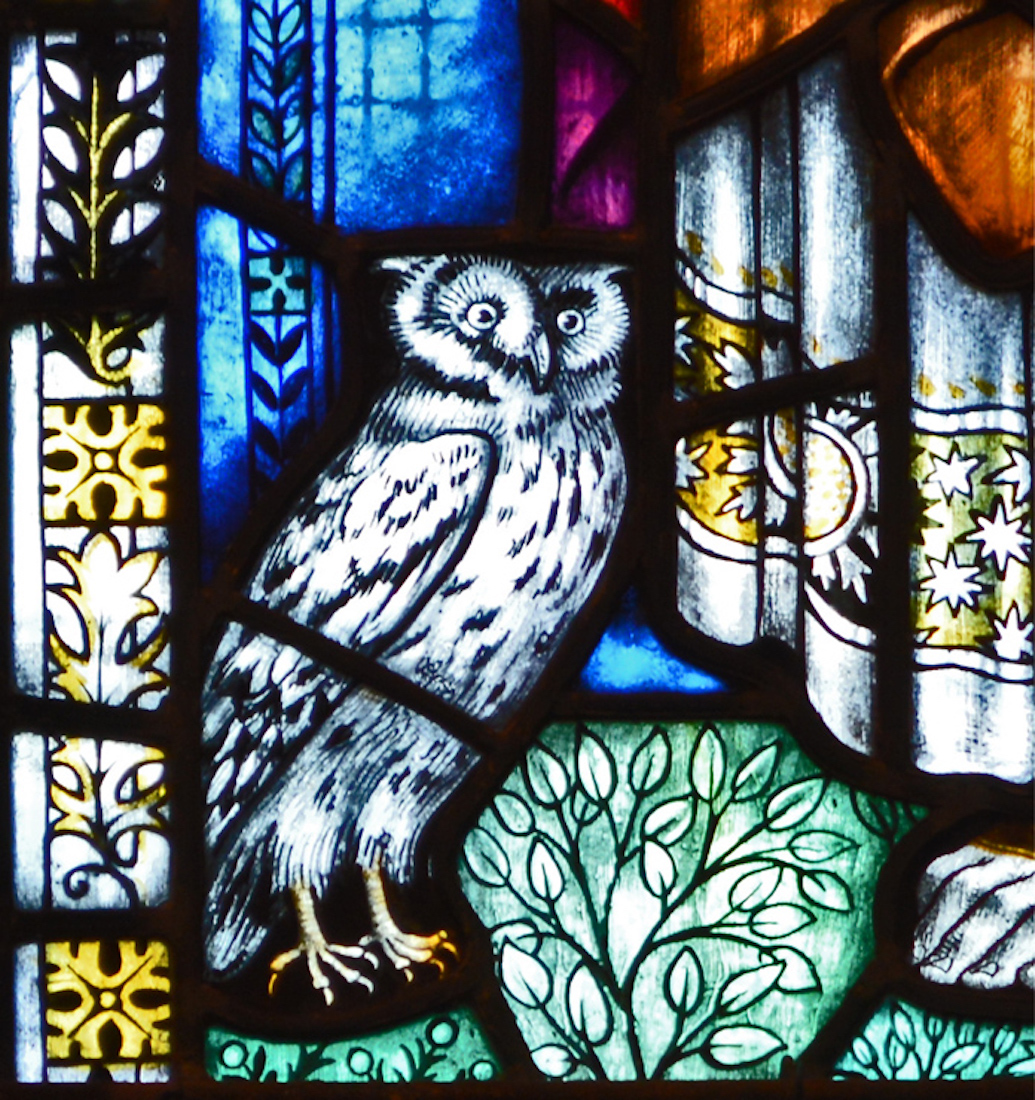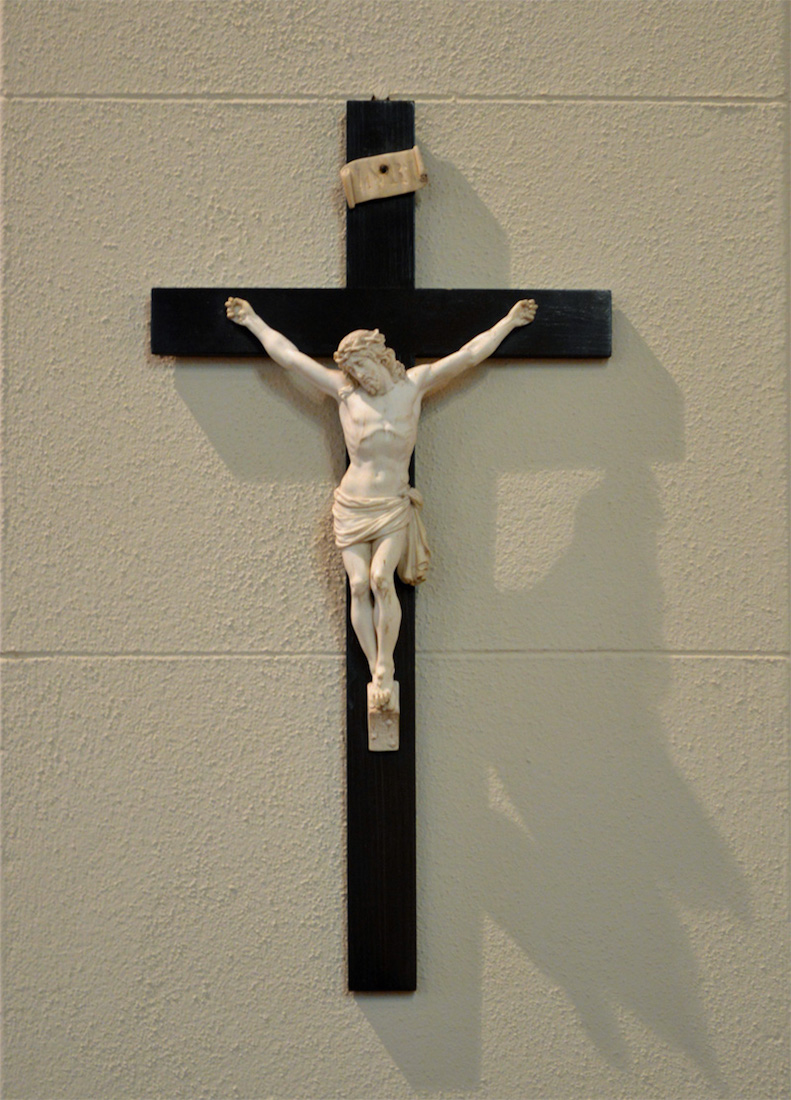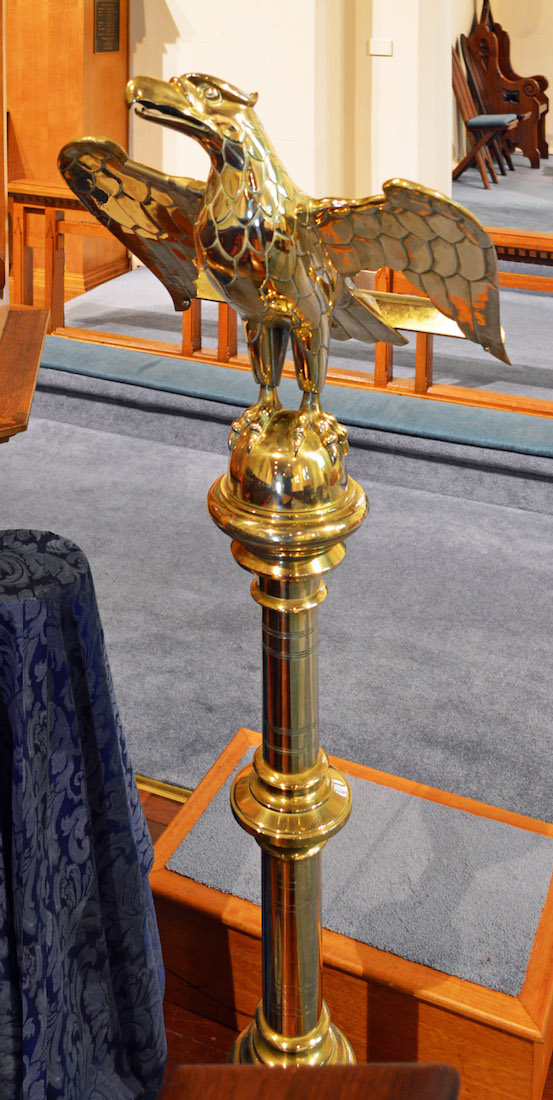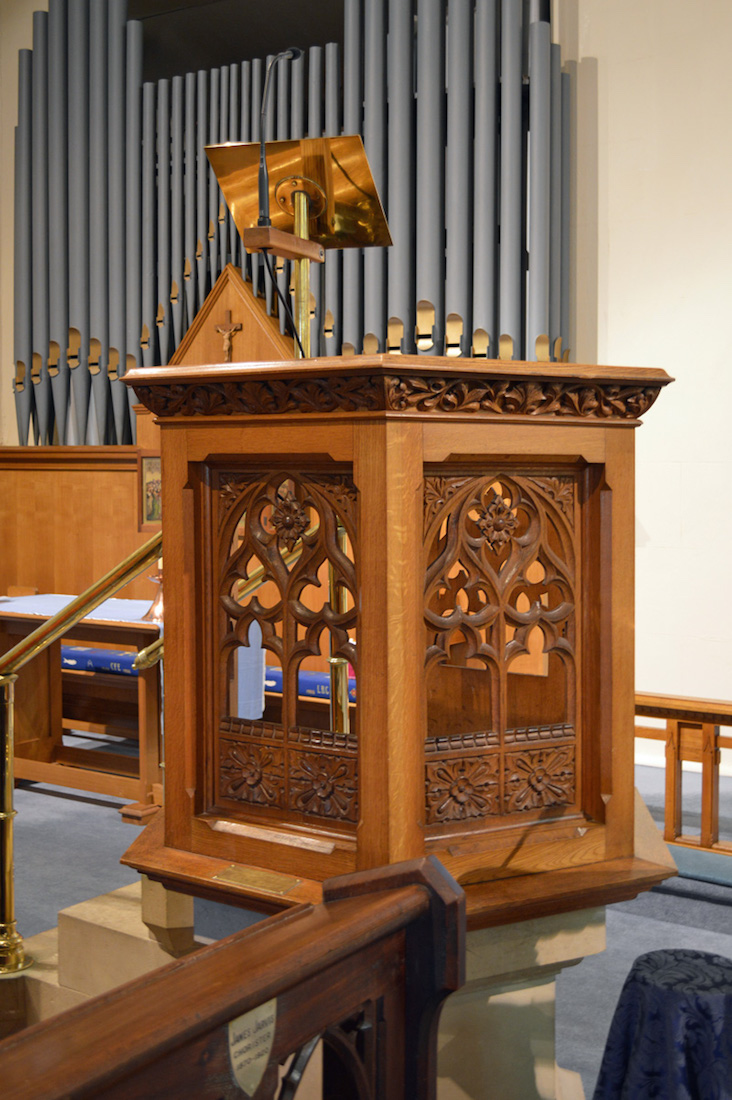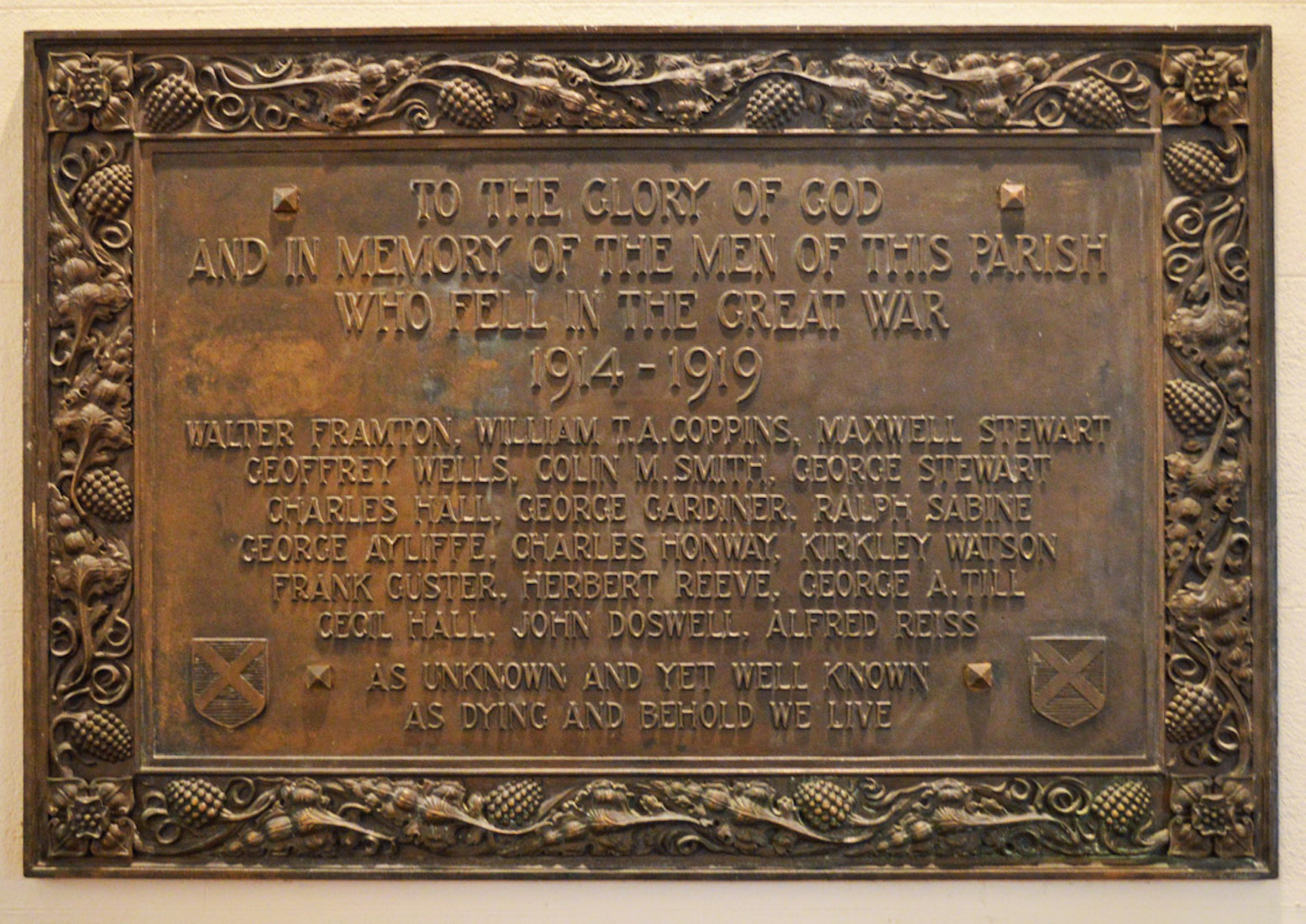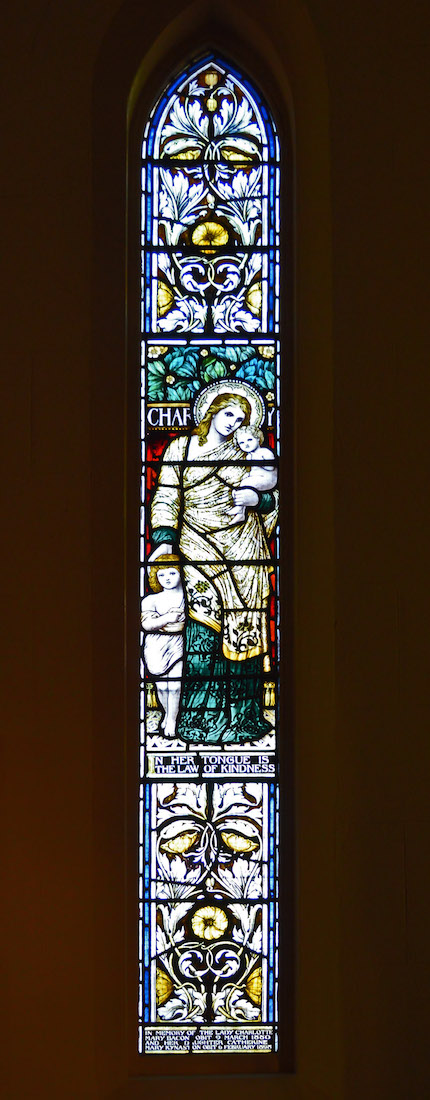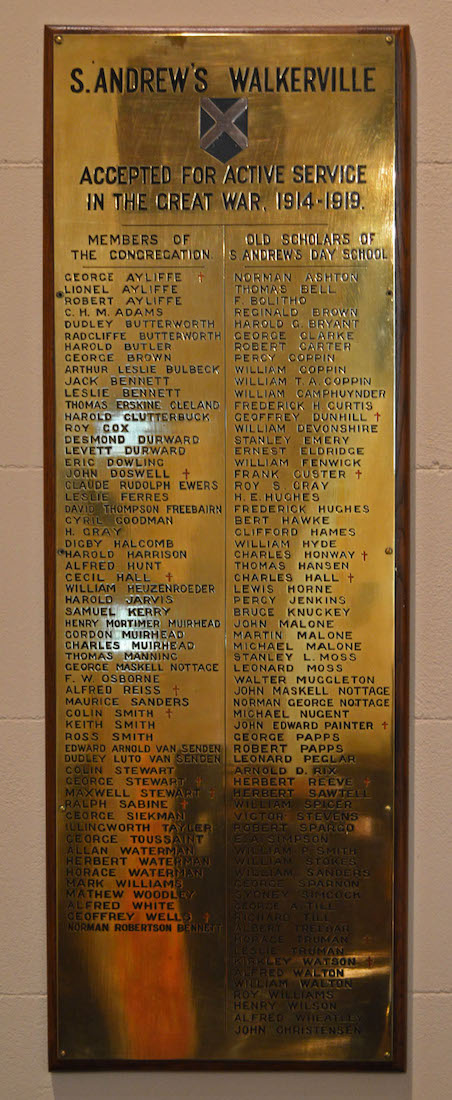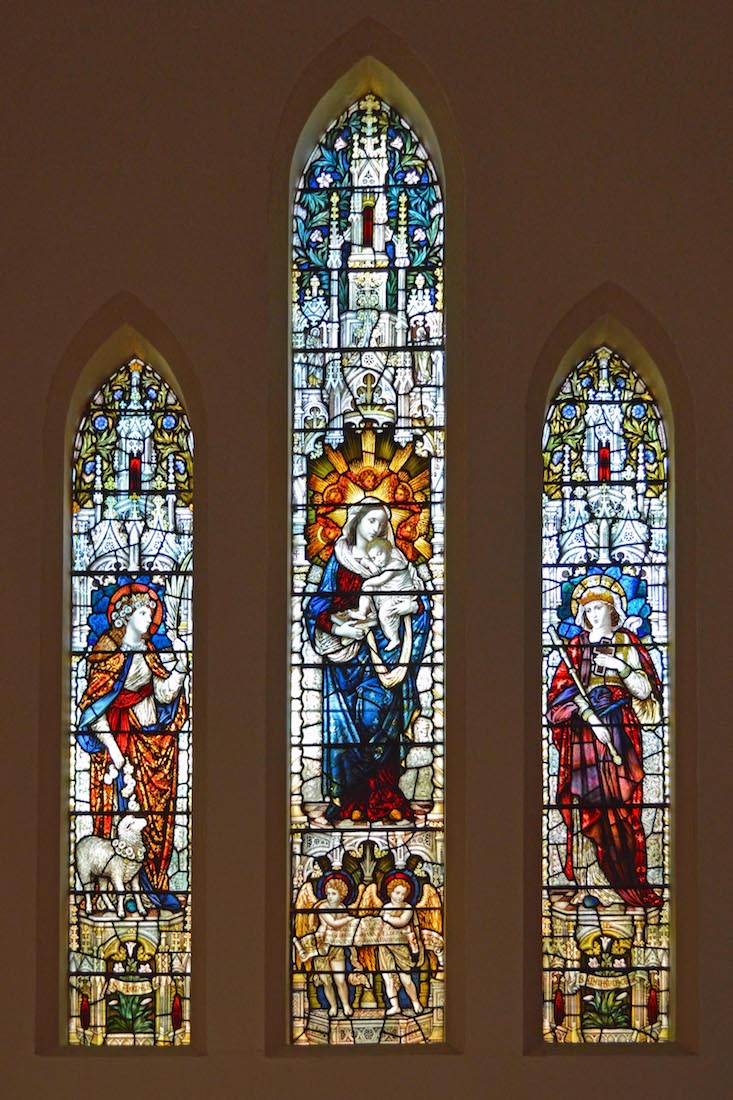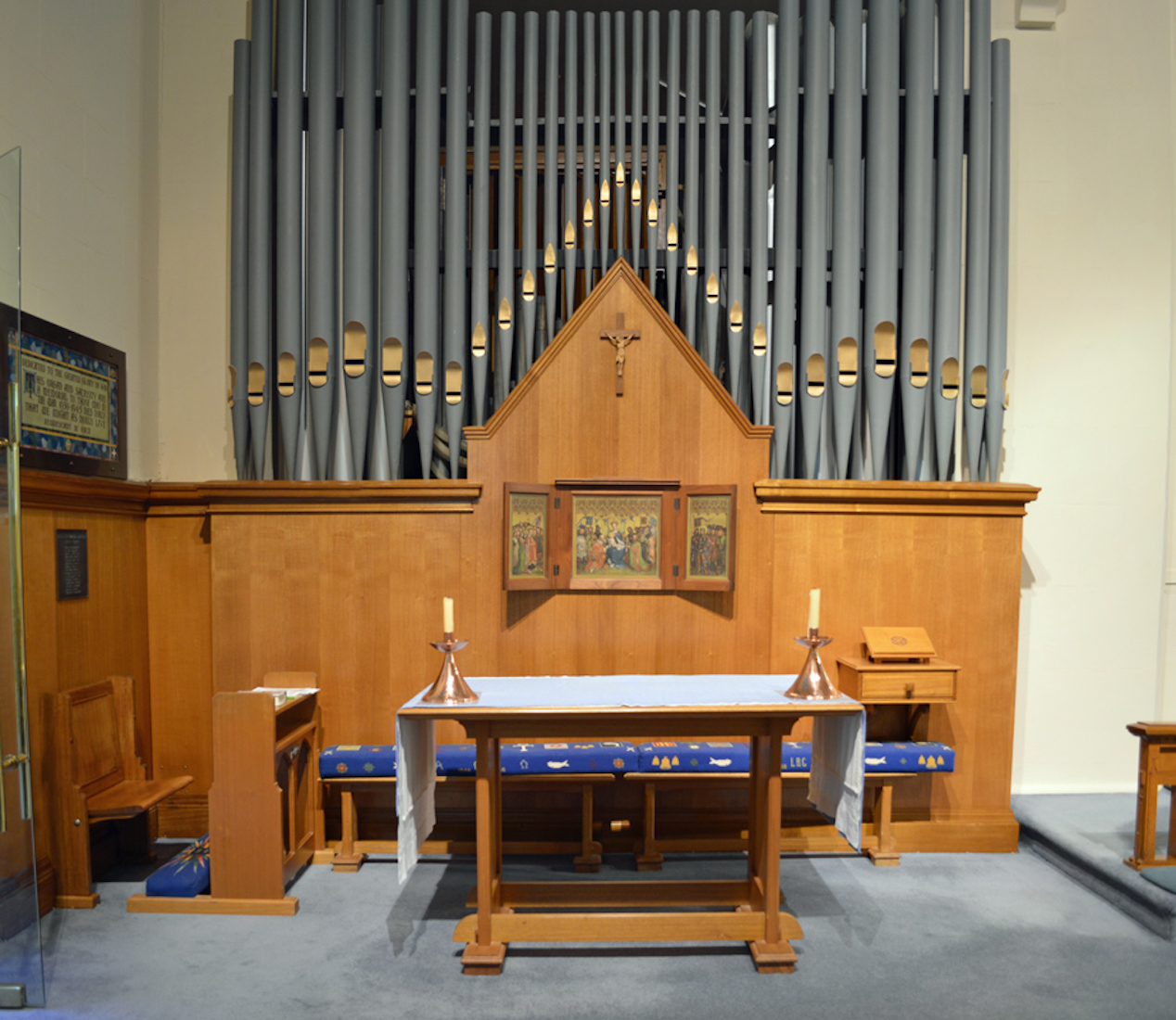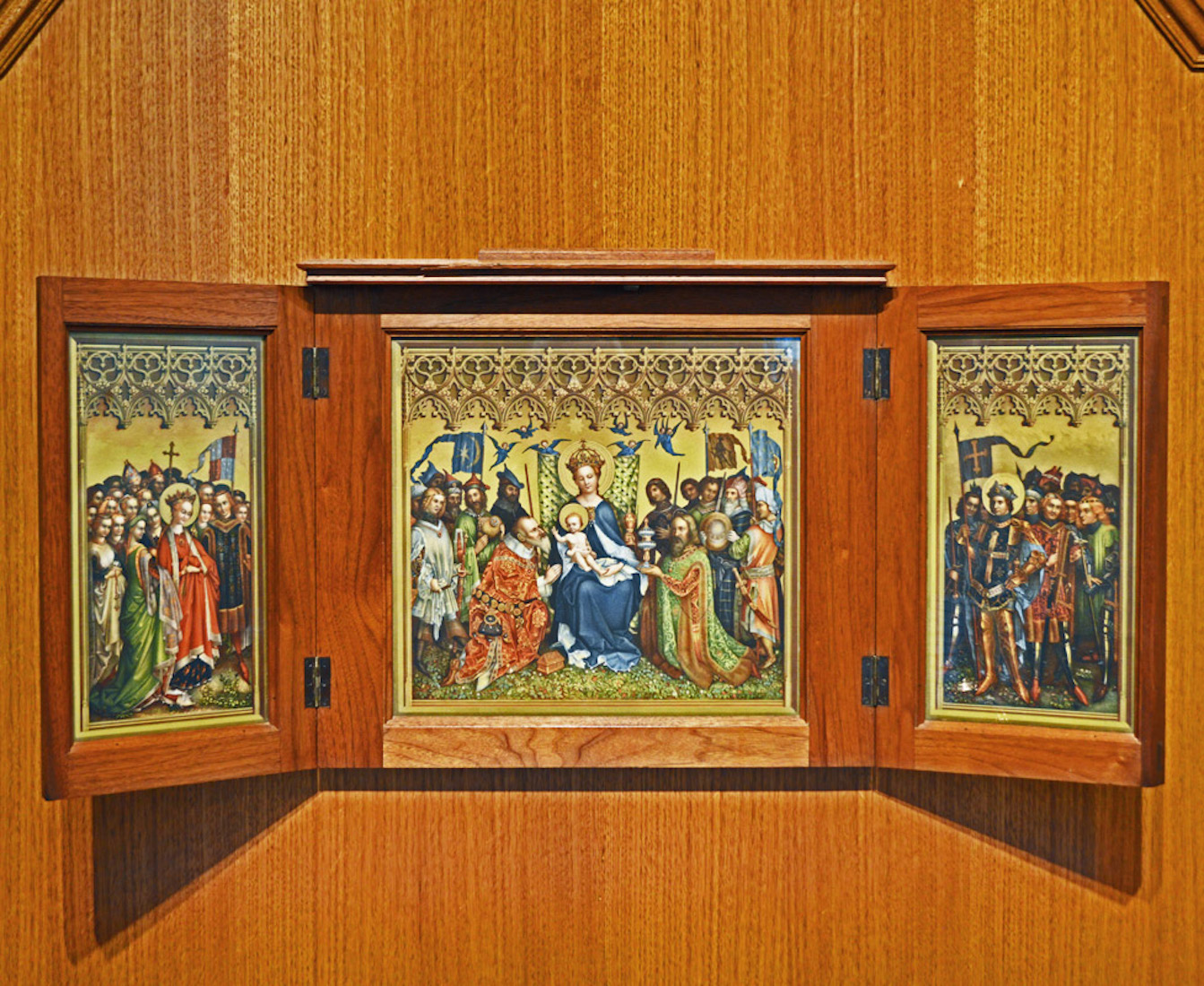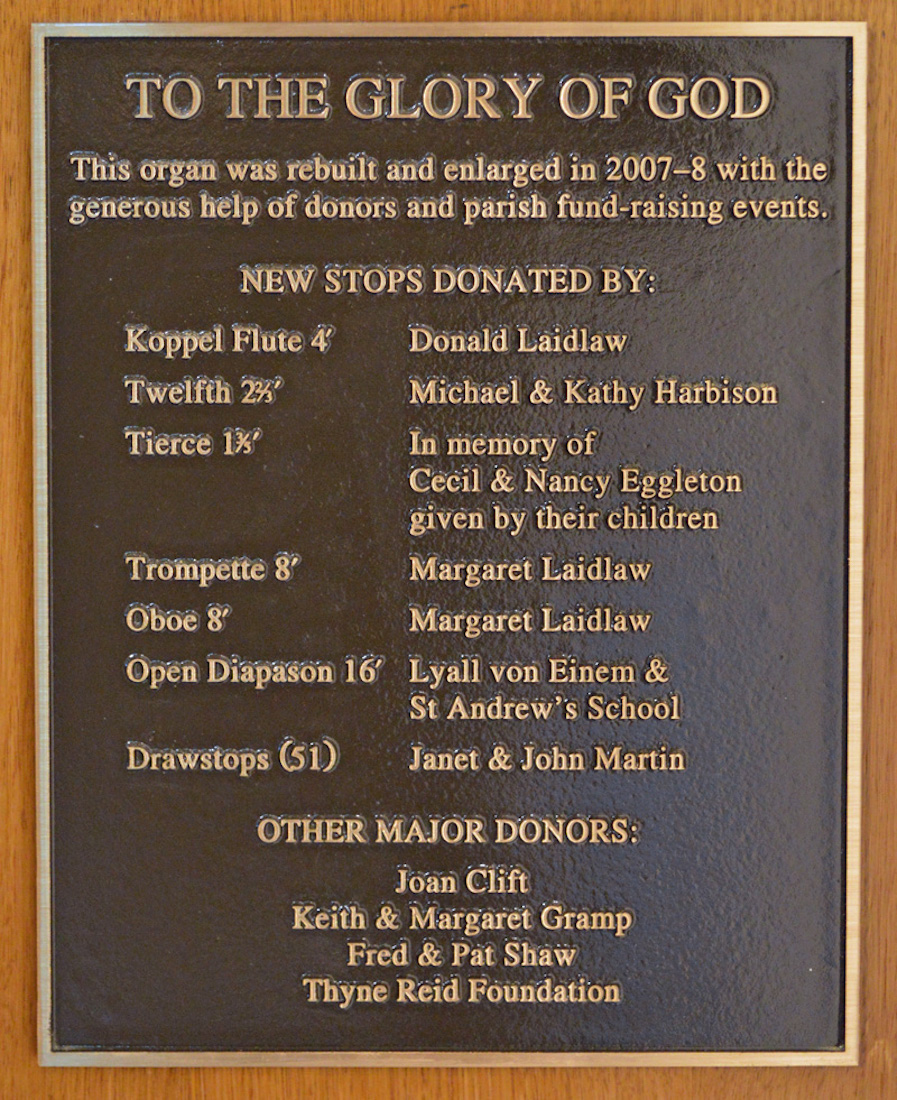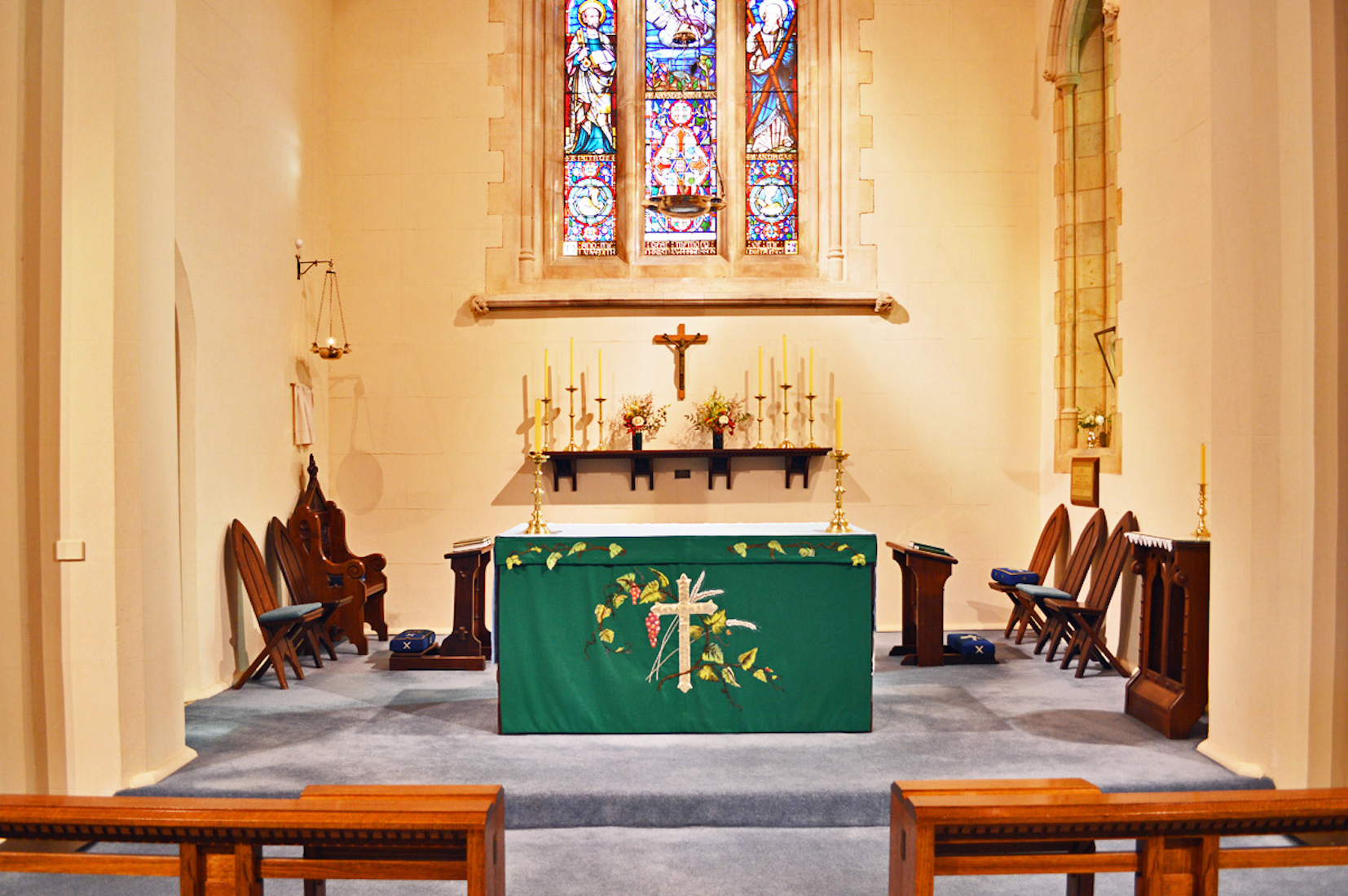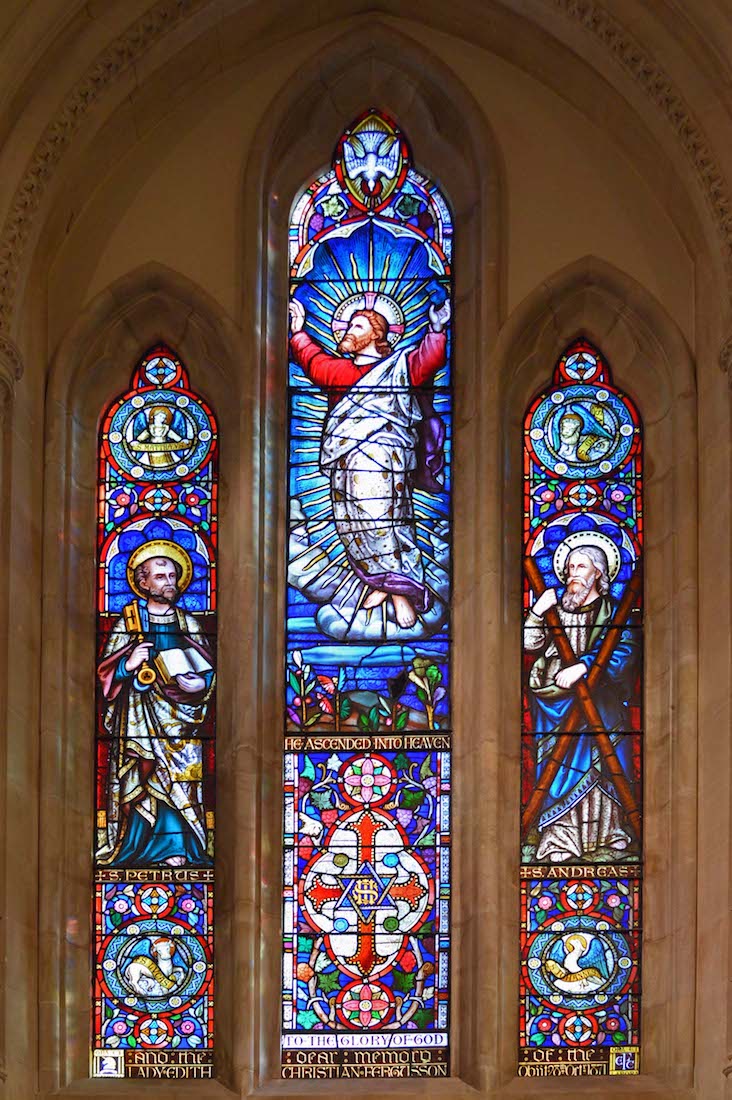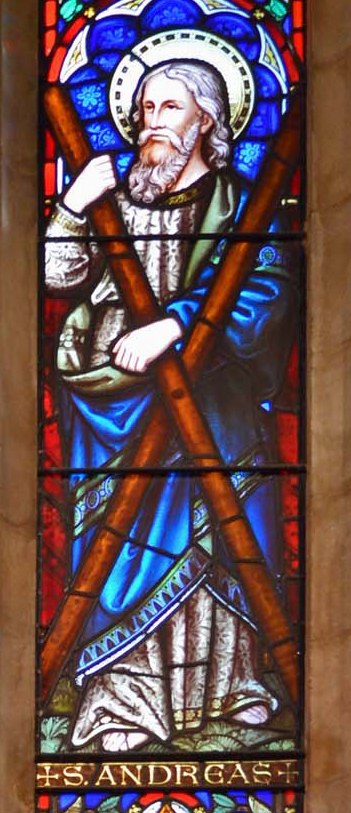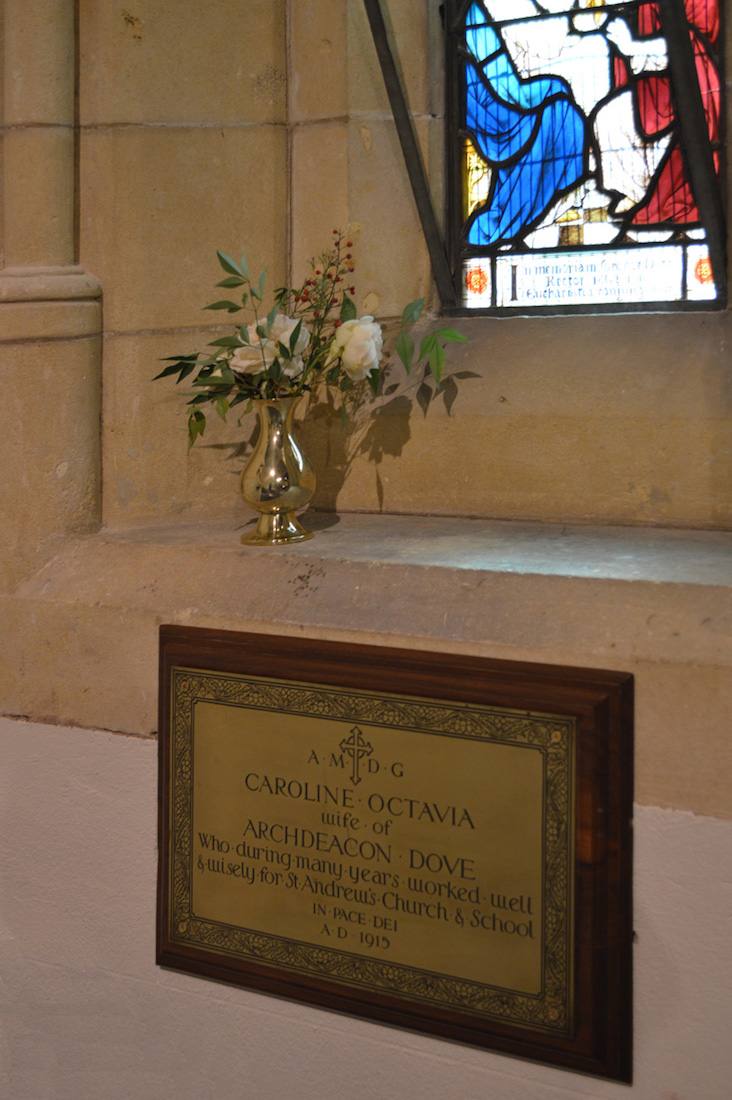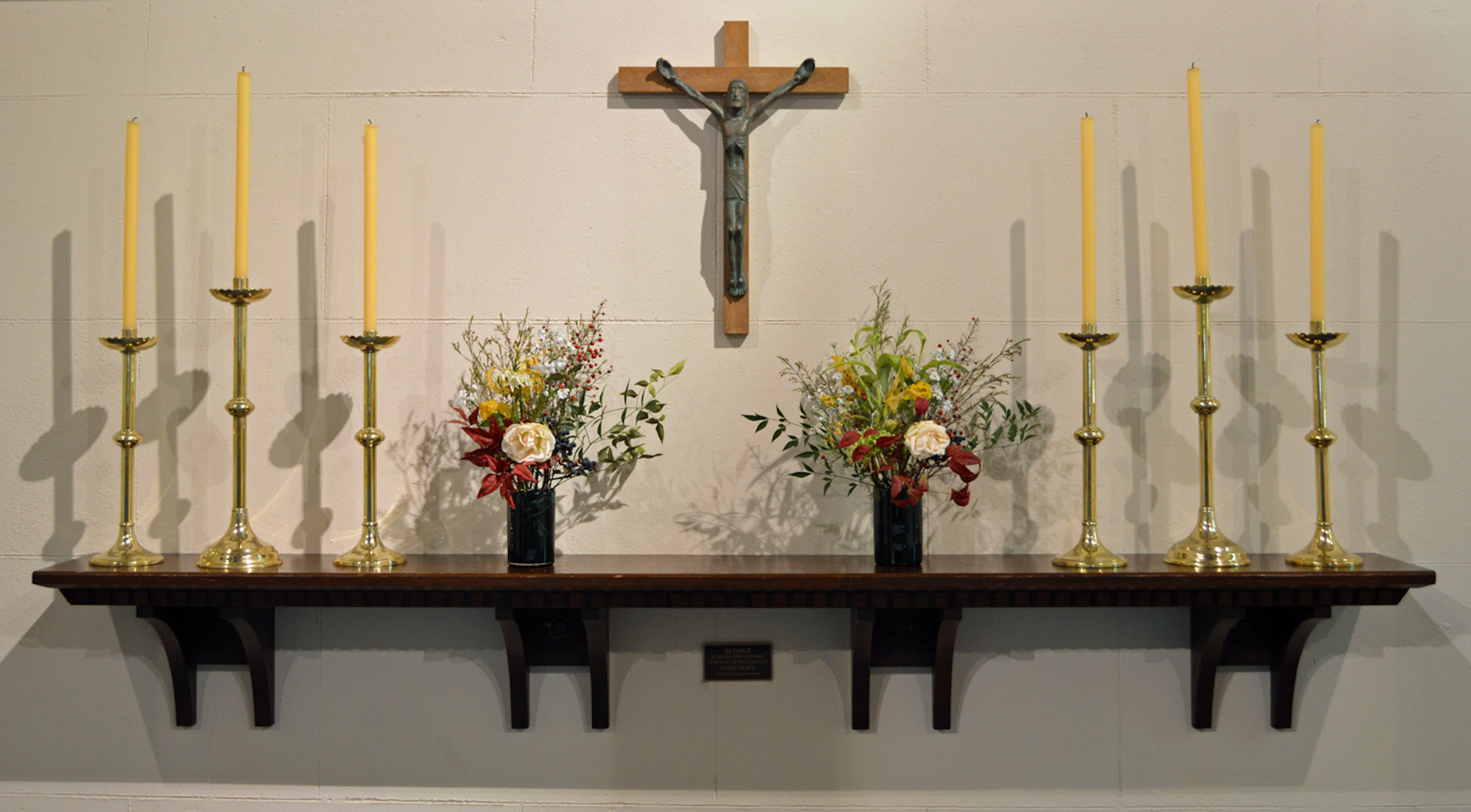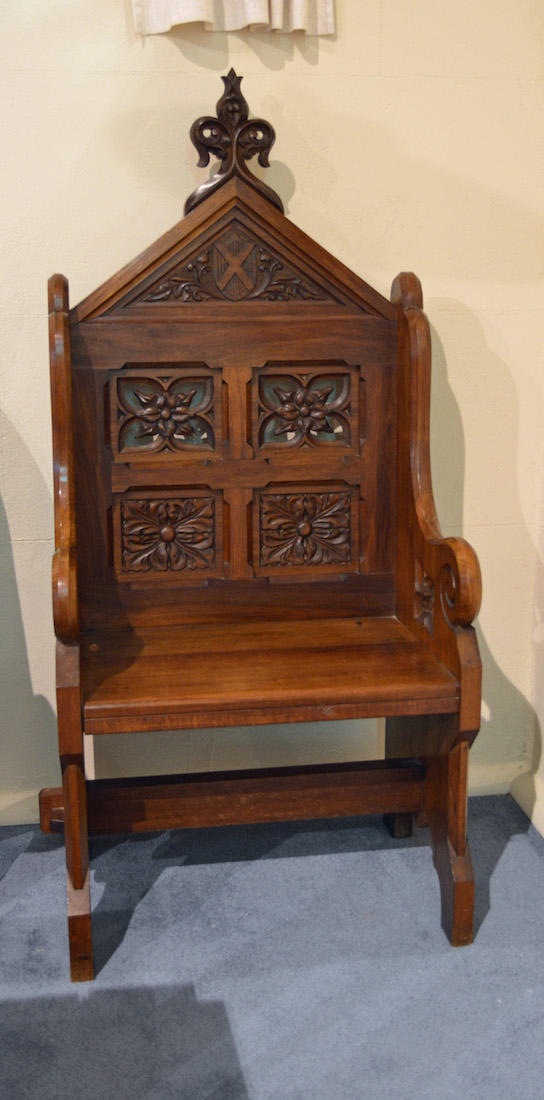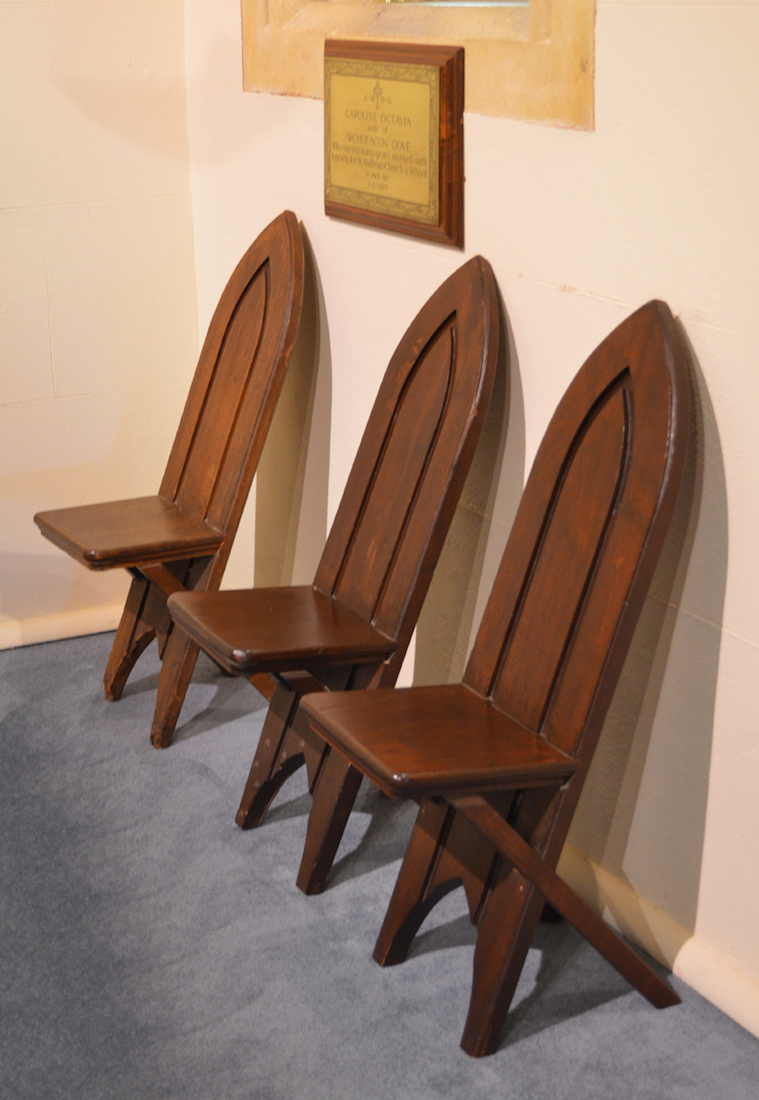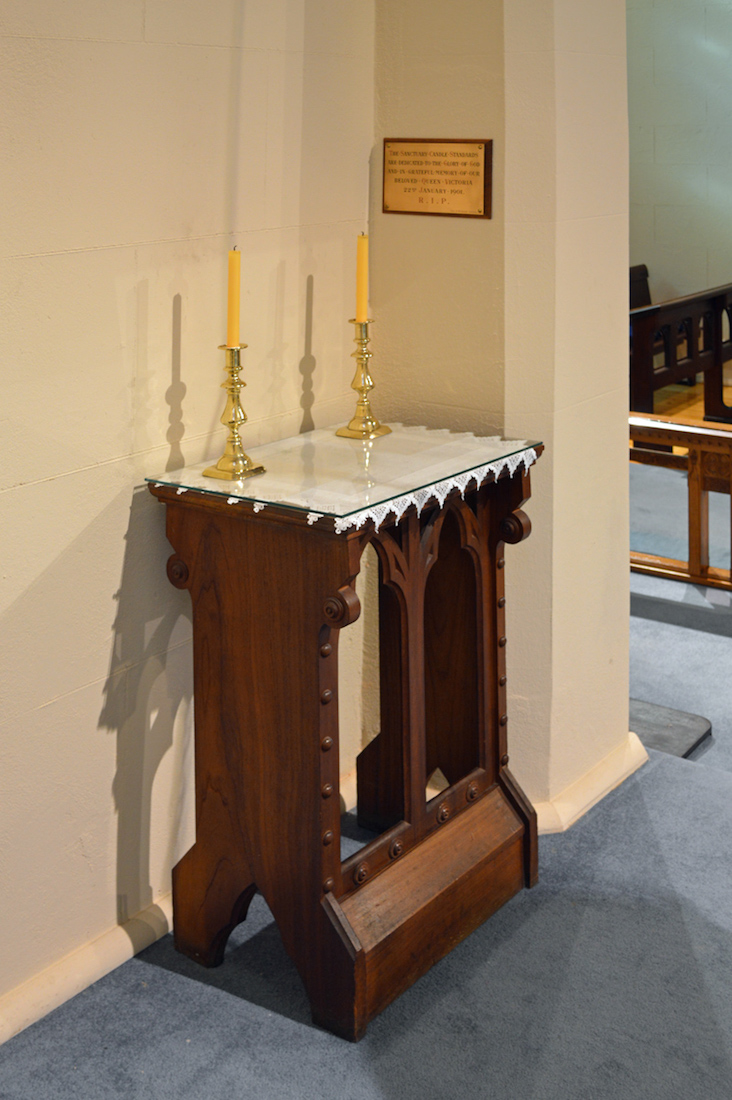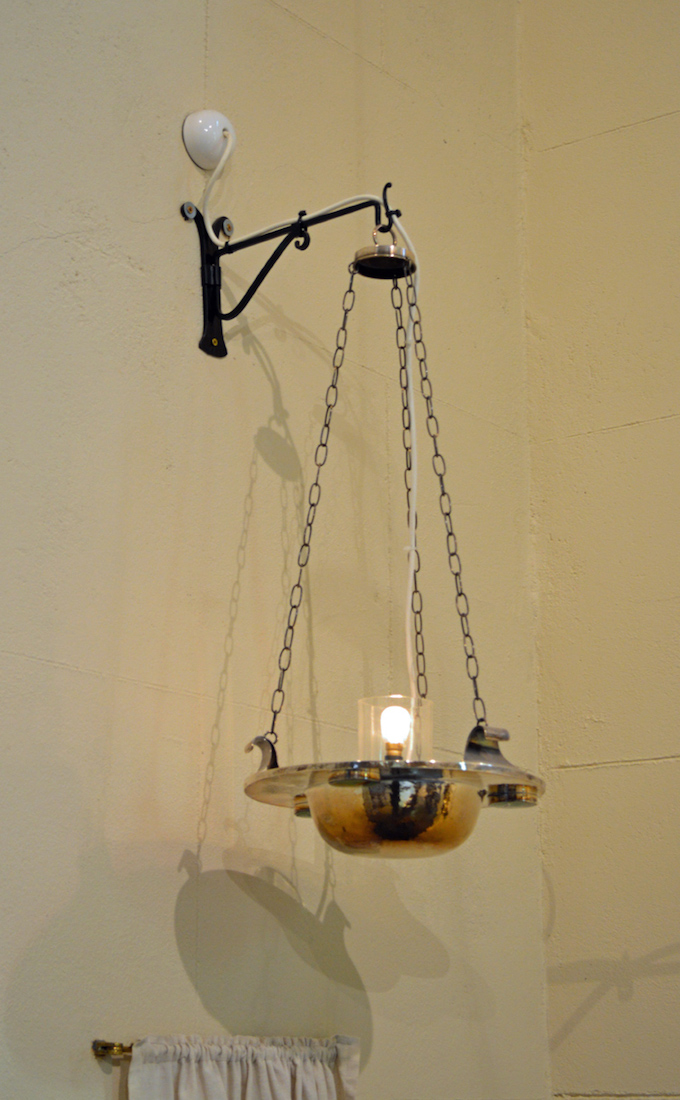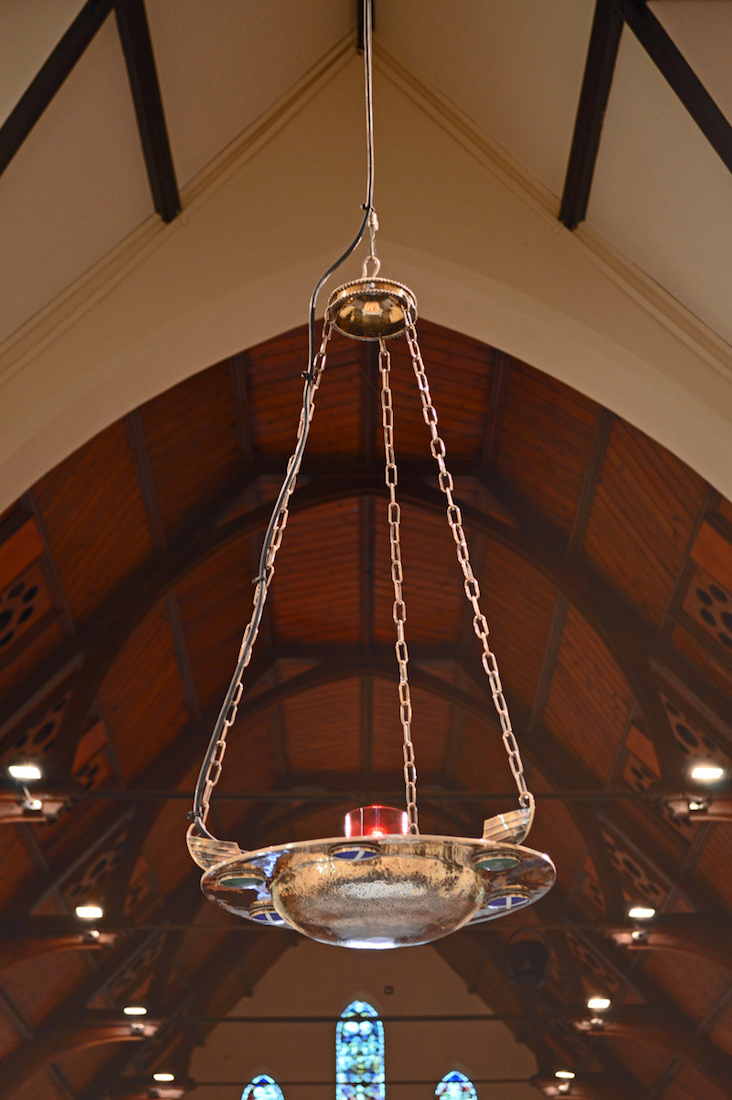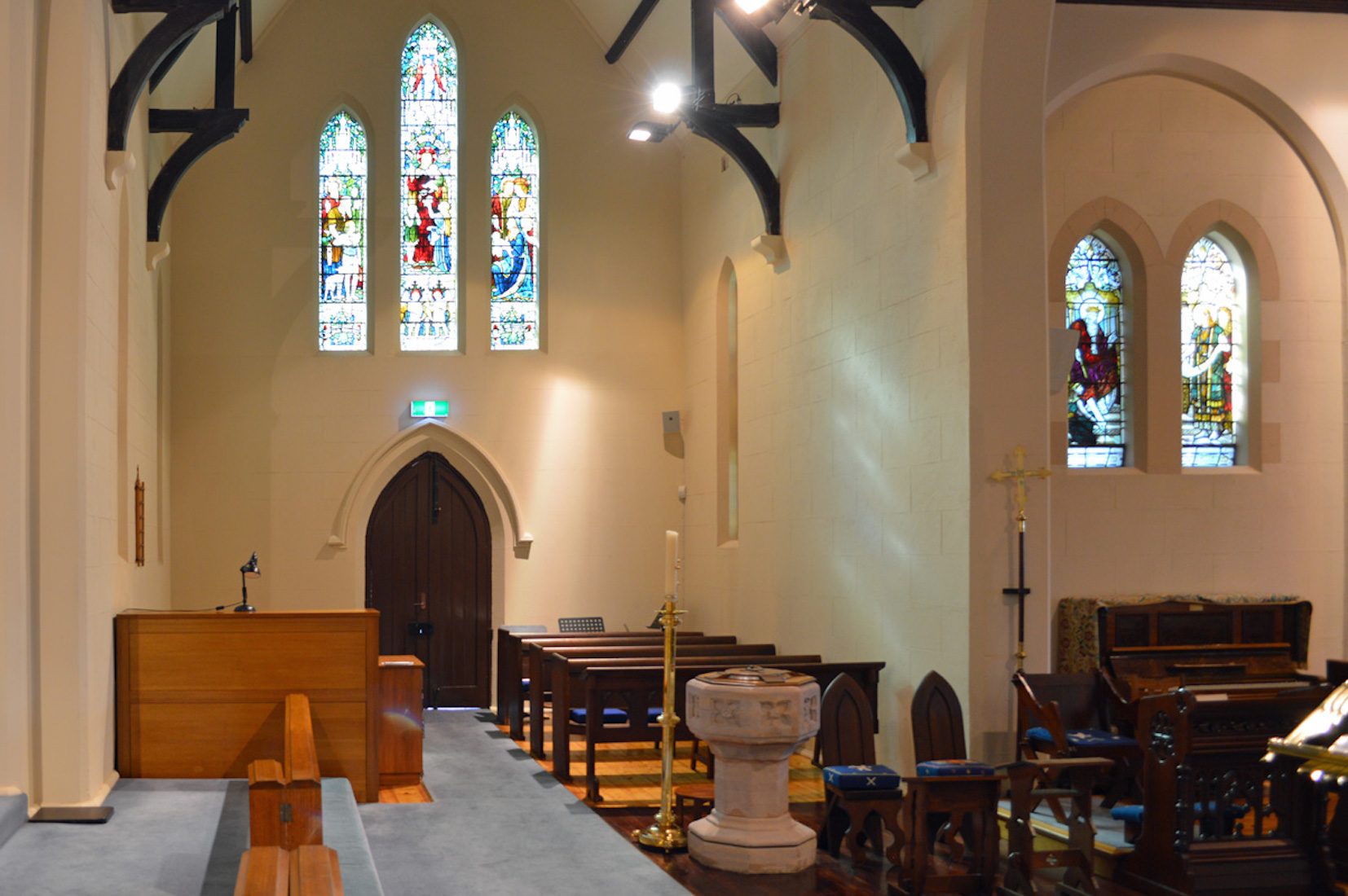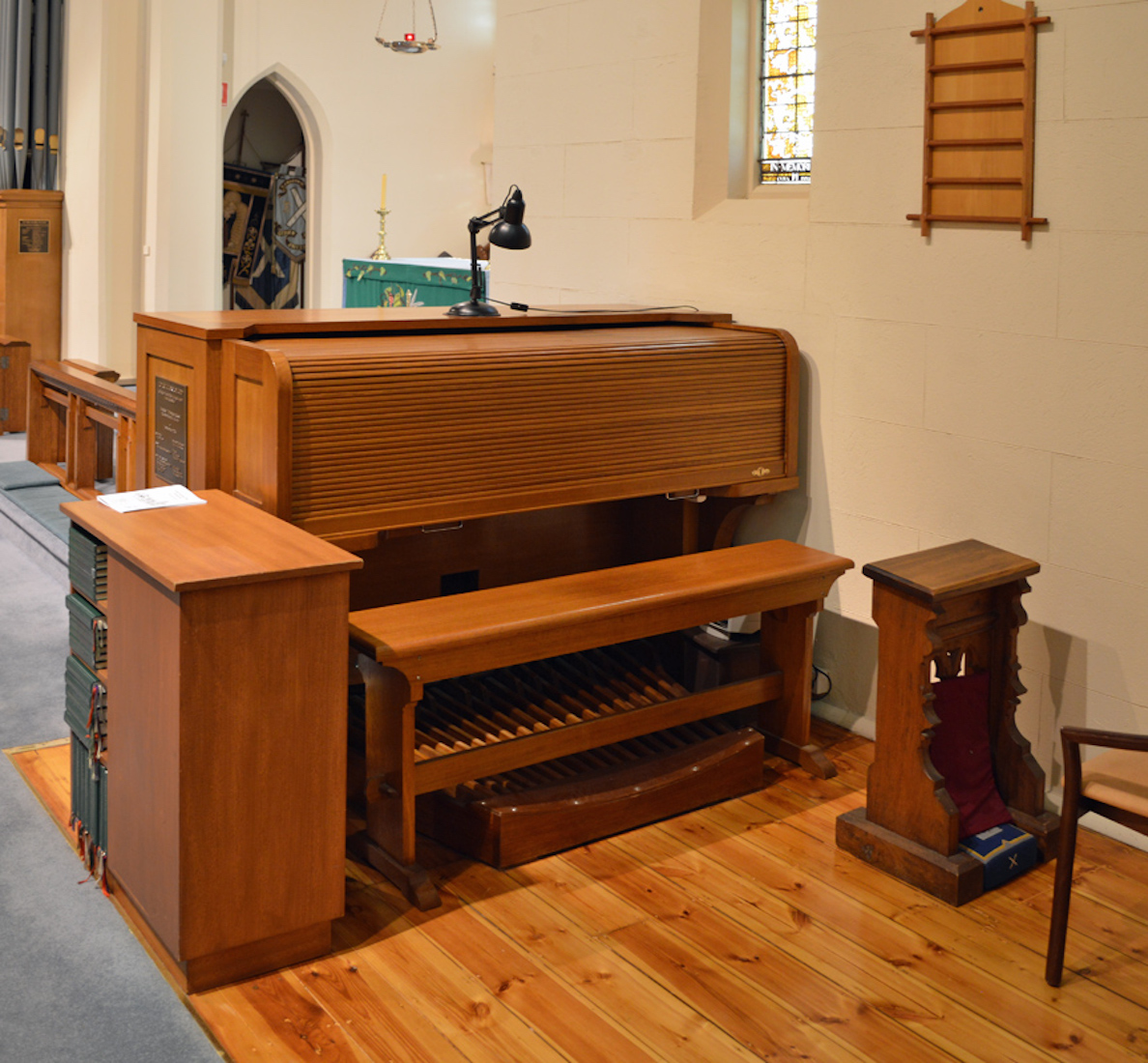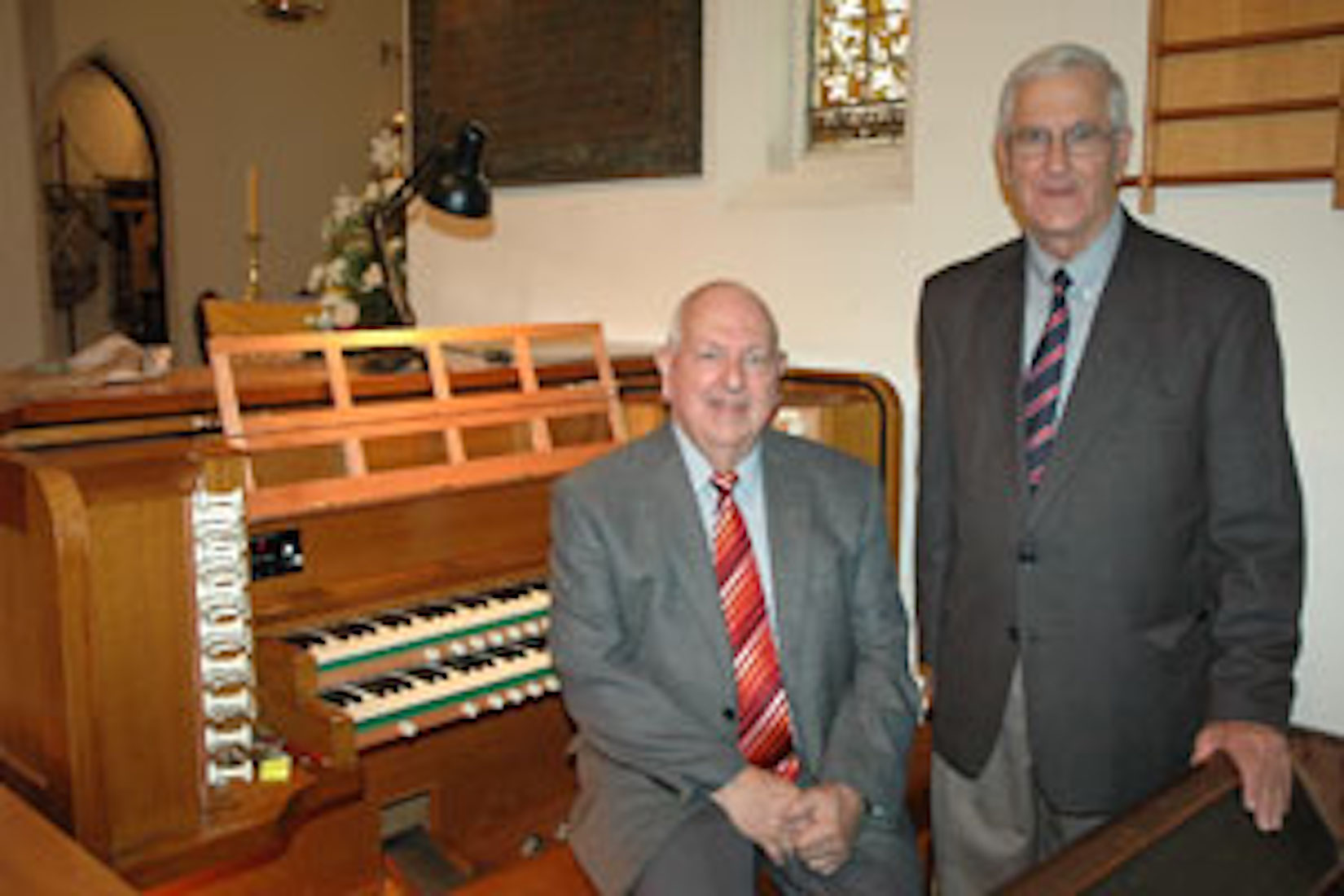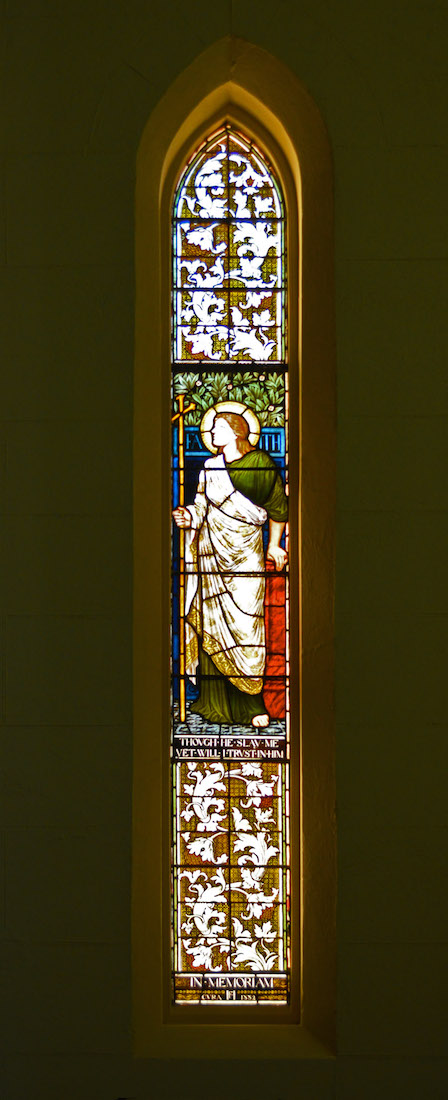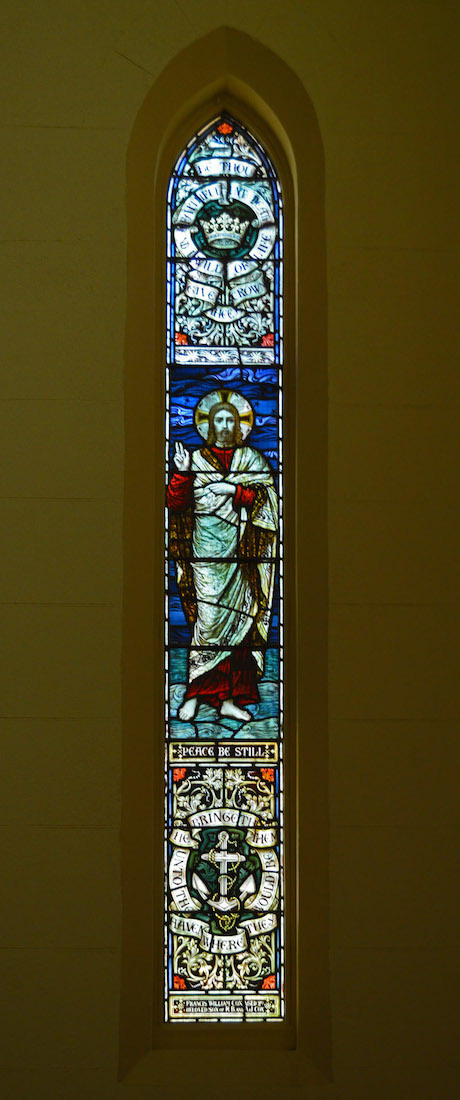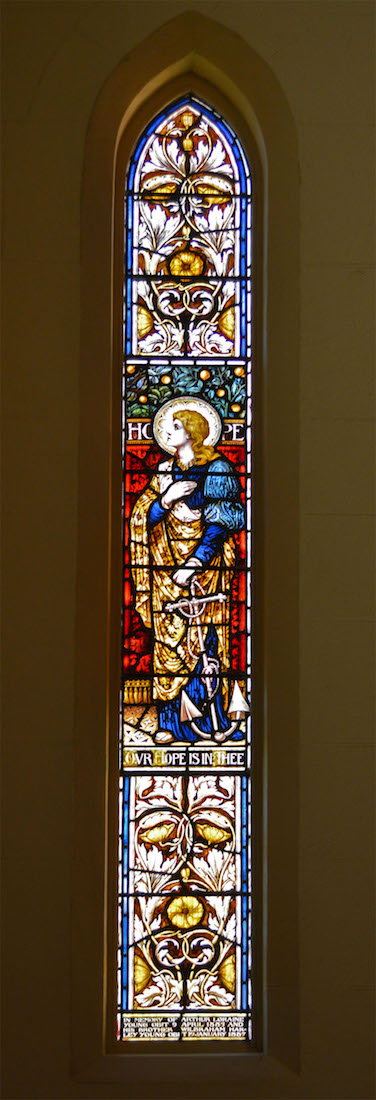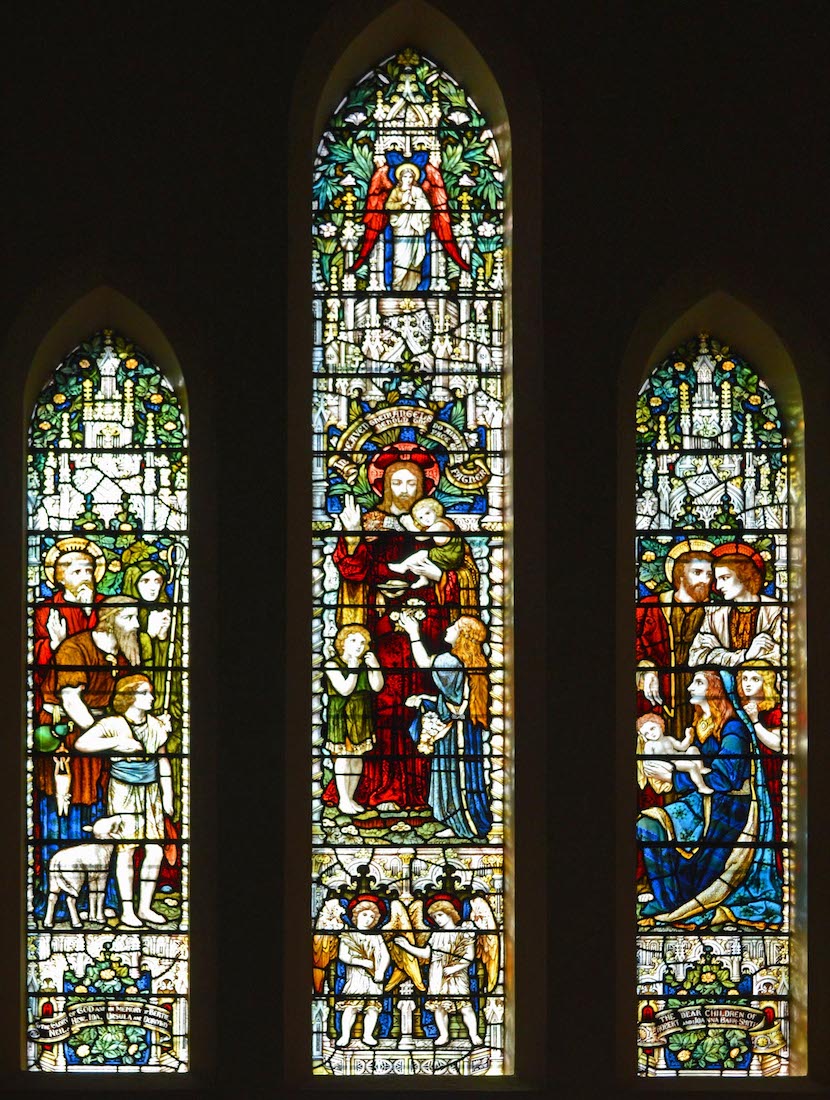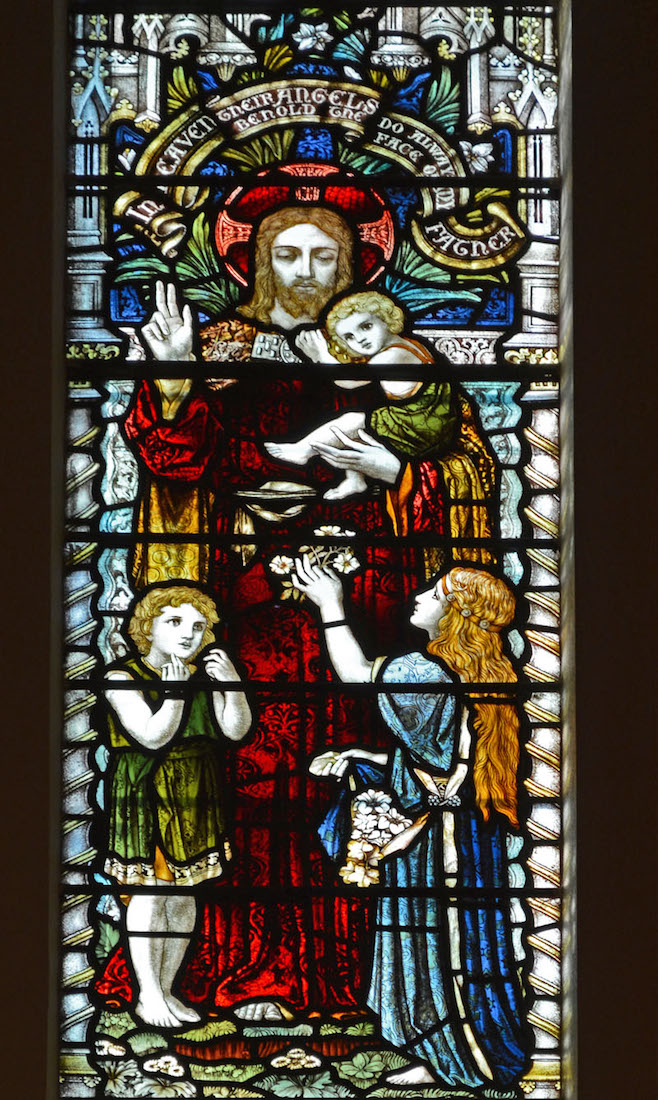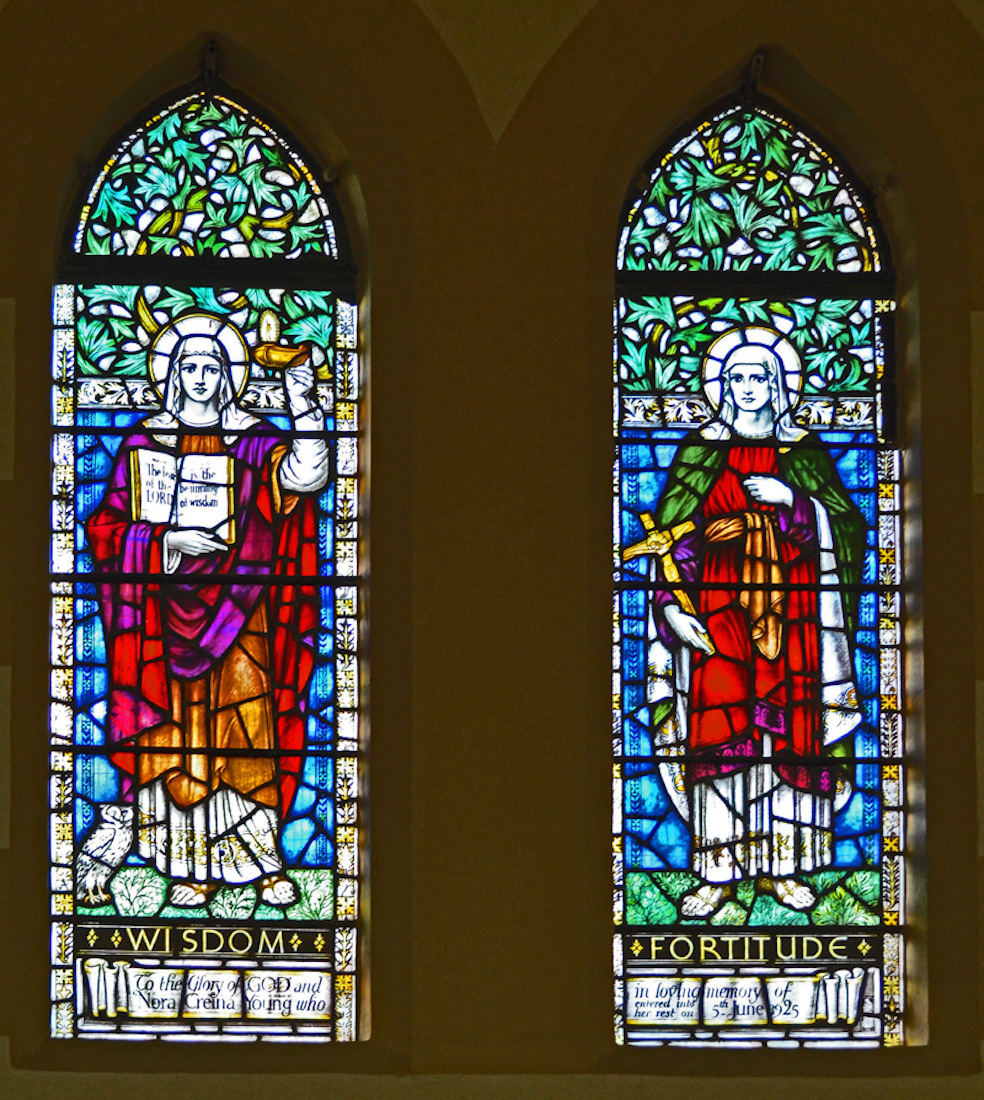
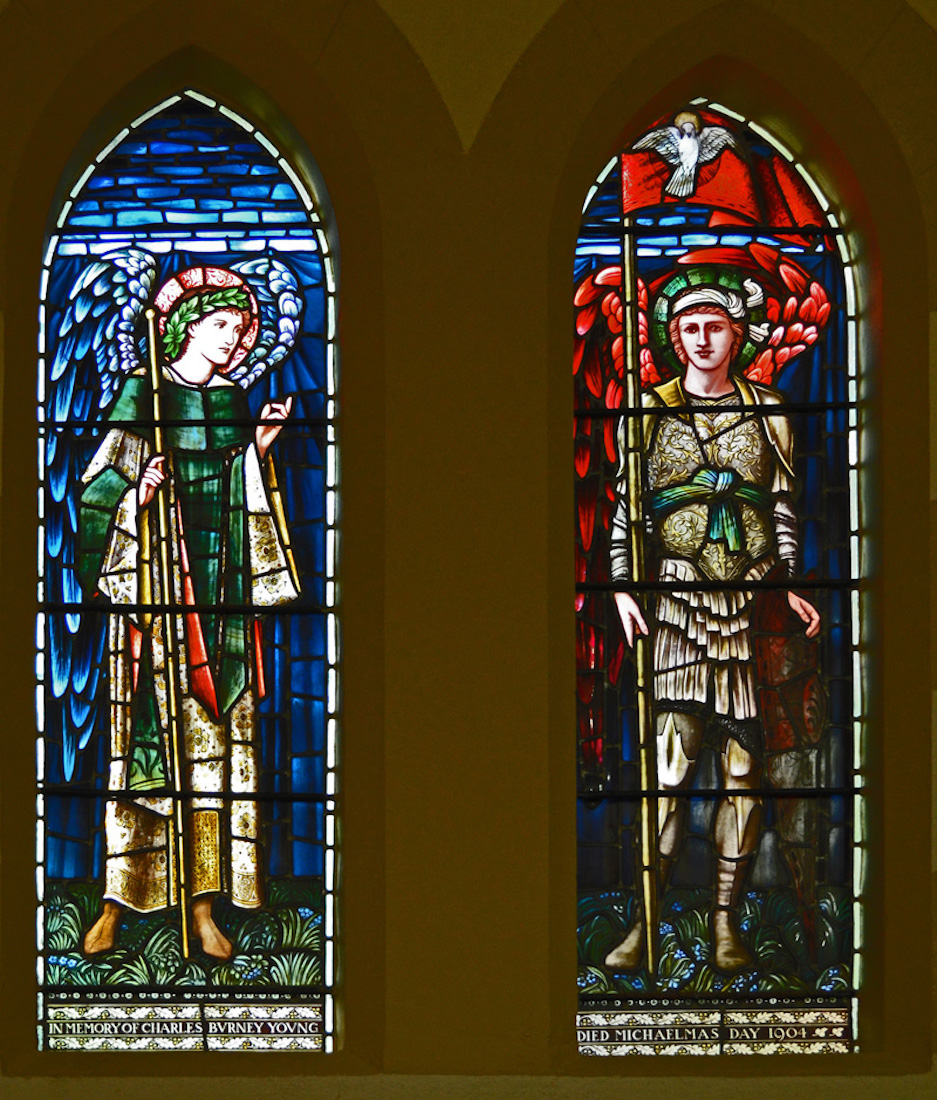
The final pairs of windows on this wall show at left, Wisdom (a woman holding Book of Proverbs, and owl at base) and Fortitude. Inscription: “To the glory of God and in loving memory of Nora Creina Young who entered into her rest on 5th June 1925.” Maker: James Powell and Sons. The right pair show archangels Gabriel (the messenger)and Michael (the warrior). There are thirty angels shown in the windows of this church. Note the flesh colour of the figures. Inscription: “In memory of Charles Burney Young, died Michaelmas Day 1904.” (Placed by his widow Nora Creina Young in 1908) Maker: William Morris & Co. London. ![]()
22. NORTH TRANSEPT
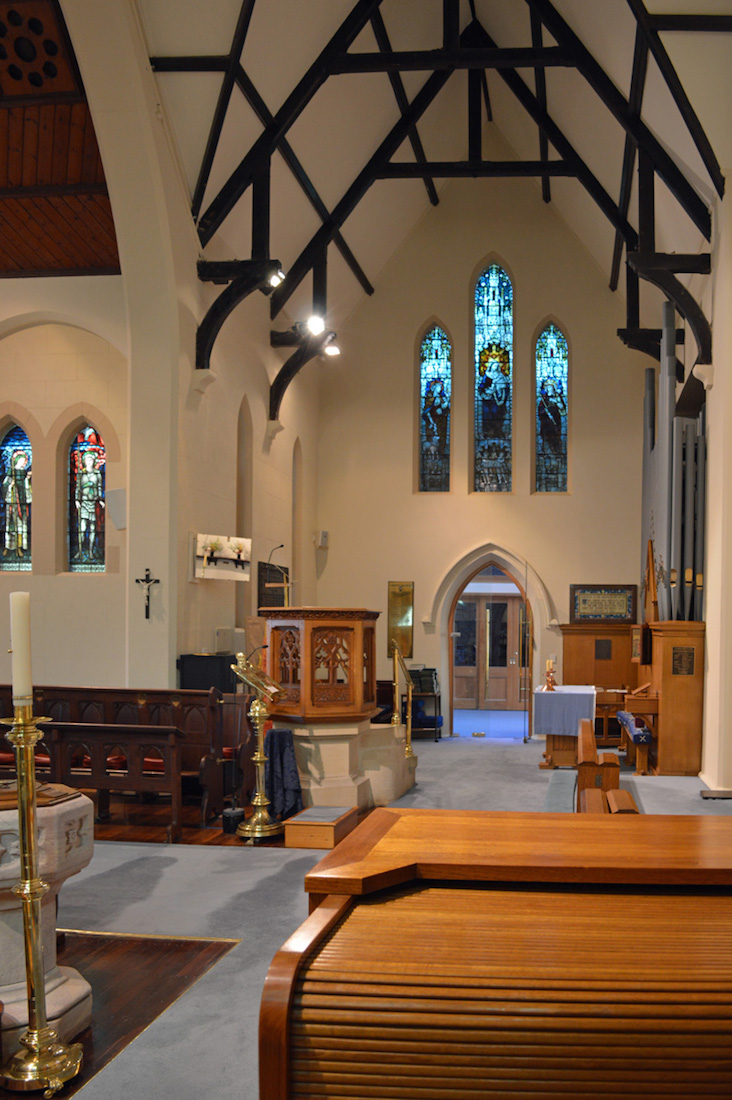
Having reached the end of the nave North wall, we stand back and look towards the North transept. At the corner is a crucifix, and to the right a lectern and pulpit. Behind, on the West wall, are a mirror(!), and two single lancet windows separated by a board. On the North wall of the transept, we see three lancet windows, and a couple of memorials flanking the doorway out to the foyer of the Parish Centre. On the East wall there are organ pipes, and an altar. Note the little plaque on the near end of the altar.
23. OWL AND CRUCIFIX
At right is the corner crucifix. Above the figure of Christ, the acronym INRI (Iēsus Nazarēnus, Rēx Iūdaeōrum) represents the Latin inscription which in English reads as "Jesus the Nazarene, King of the Jews". John 19:20 states that this was written in three languages: Hebrew, Latin and Greek during the crucifixion of Jesus. At left we have backtracked to the ‘Wisdom’ window, for a closer look at 'The wise old owl’.
24. LECTERN, PULPIT
Standing near the corner of the crossing are the expected brass eagle lectern and a decorated pulpit. The Bible rests on the lectern and it is from here that the Scriptures are read during times of public worship. The eagle is a symbol of strength. Inscription: ‘In loving memory of Caroline Marion, eldest daughter of Archdeacon Dove, this lectern is here placed by her friends MDCCCXC [1890]. The hexagonal pulpit was first used for Easter services in 1914. It is made of elaborately carved oak and sits on a pedestal of Murray Bridge freestone. It was given in memory of Robert and Sarah Virgo Williams, worshippers in this church 1849 – 1910.
25. NORTH TRANSEPT, WEST WALL
On the West wall of the North transept is a war memorial flanked by two windows. The window at left depicts The Good Shepherd, and is given ‘In memory of Caroline Marion 1889 and Lionel 1868, children of George and Caroline Octavia Dove’ (a former rector and his wife). Maker (both windows): Jas Powell and Sons. The window at right is ‘Charity’. Charity is Identified here with the good wife in Proverbs 31:26. Inscription: ‘In memory of the Lady Charlotte Mary Bacon obit 9th March 1880 and her daughter Catherine Mary Kynaston obit 9th February 1898’ (mother and sister of the donor Mrs Burney Young).
26. NORTH TRANSEPT PLAQUE, WINDOW
The brass plaque on the North Wall lists those accepted for service in the Great War. The window depicts St Agnes, the Madonna and Child, and St Margaret of Scotland. This chapel window is now backlit by a skylight from the new Parish Centre. Agnes (304A.D.) was a young girl martyred at Rome, and Margaret (1045 – 1093A.D.) saintly Queen of Scotland, was reputed to have had a good influence over her husband King Malcolm III. Inscription: ‘To the glory of God and in memory of George and Joanna Elder, dear parents of Joanna Barr Smith’ Maker: James Powell and Sons, 1894.
27. NORTH TRANSEPT CHAPEL
The sacristy and organ chamber were built in the early 1960s. The chapel was created by the space left after the old organ was removed in the late 1950s. The chapel is used for smaller services, usually during the week. The most regular use of the chapel is the midweek Holy Communion service. The rector usually says his daily prayers in the chapel.
28. TRIPTYCH
A focal point of the chapel is this colourful triptych. I have not found any details of this, but it appears to show the Magi bringing gifts to the Madonna and Child, in a time of lords and ladies.
29. CHAPEL CRUCIFIX AND KNEELER
Above the triptych is a wooden carved crucifix, and below some colourful kneelers decorated with Christian symbols.
30. THREE PLAQUES
Close by the chapel altar are three memorials. On the wall at the left of the altar is the blue and gold framed poster in memory of those who died in World War II. Below this is the large bronze plaque recording donations given for the rebuilding of the organ. Then on the right hand end of the altar is the small bronze plaque (bottom right) recording the names of those (presumably parishioners of St Andrews) who gave their lives in World War II.
31. SANCTUARY
Leaving the North transept (chapel) we return to the crossing, and look towards the sanctuary. At left is a glimpse of a doorway leading through to the sacristy. There are various chairs and kneeling stands. At right is a small credence table. At centre is the main altar, behind which is a retable (shelf) carrying various vases and candle sticks, then a crucifix, and the main East window. At right is a further single lancet window, with a brass plaque and vase of flowers. Above the altar is a sanctuary lamp, and there is another on the wall at left.
32. SANCTUARY WINDOW
The main East window depicts St Peter (left) the Ascension (centre) and St Andrew (right). Peter holds the keys to the kingdom of heaven and the gospel. Andrew as an old man is holding the cross on which he died. The cross is diagonal because Andrew would not be crucified in the same way as Jesus. This is the earliest window. Inscription: ‘To the glory of God and in dear memory of the Lady Edith Christian Fergusson obit 28th October 1871.’ She was a devoted church woman and wife of the Governor of South Australia, Sir James Fergusson .Maker: Ferguson and Urie, Melbourne. Stonework designed by E T Woods.
33. SANCTUARY SOUTH WINDOW
The small window in the side wall of the sanctuary shows Christ the High Priest, holding the cup, with the inscription, “I am the true vine”. Below is a picture of Jesus breaking bread at Emmaus, after he had risen from the dead. Inscription: “In memoriam George Dove, Rector 1862 – 1911” (a record 49 years) “Eucharistia conjungimur” (let us join together with thanks) Maker: James Powell and Sons, 1915. A vase of flowers is placed on the sill of the window each week as a reminder of his fondness for the people of the parish, and his love of roses. The plaque below the window also commemorates the ministry of his wife Caroline Octavia Dove.
34. SANCTUARY RETABLE
The retable (shelf) with its candlesticks and small vases makes an attractive backdrop to the altar. It was given by Marc and Joan in memory of their mother Mary Clift who died on 25th March 1980. The information plaque sits just below the shelf, and the crucifix is above.
35. SANCTUARY FURNITURE
Various chairs line the sanctuary walls – presumably the rector’s carved chair at left. The credence table is on the right hand side. The credence table is usually placed near the wall on the South side of the sanctuary, and may be covered with a fine linen cloth. It is sometimes tended by an acolyte or altar server, and contains on it the implements that are used in the Eucharistic celebration, which may include the bread and wine prior to their consecration, a bowl, ewer and towel for the lavabo and the ablutions after Holy Communion.
36. SANCTUARY LAMPS
The red lamp (right) hangs centrally over the altar and burns day and night to remind us of God’s constant presence. This lamp was given in memory of Edith Florence Ekers (1877 – 1959) and George Harold Ekers (1877 – 1967). The white aumbrey lamp which hangs on the North wall of the sanctuary indicates the presence of the Sacrament of Holy Communion kept from time to time in the aumbrey, which is set into the wall. This Sacrament is generally used for Communion for people who are sick and cannot attend public worship in the church. The silver light holder was given in the 1960s by Lady Newland in memory of her husband Sir Henry Newland, a distinguished Adelaide surgeon.
37. SOUTH TRANSEPT
Leaving the sanctuary, we step back into the crossing and look towards the South transept. A triplet of stained glass windows is set above the door, and we notice two lancet windows on the East wall, and a single lancet window on the west wall. The transept contains the organ console, and seating for the choir. Closer is the baptismal font and the paschal candle.
38. ORGAN CONSOLE
This is the third organ which has been in use in St Andrews – a complete rebuild of the second organ in 1962 by J E Dodd & Sons, Gunstar Organ Works, Plympton. An electro-pneumatic action was introduced, and the organ chamber (and sacristy) was built as a memorial to those who died serving in the armed services 1939 – 1945. The cost of the organ rebuild was £5385 plus £500 for new casework. Mr Leith Jacob and the organist Mr Lyall von Einem (inset) both worked on the 1962 organ rebuild, and in 2007 they began a restoration and rebuild which enlarged the organ by six new stops. [Photo credit: Church photo]
39. SOUTH TRANSEPT SIDE WINDOWS
The three South transept side windows ... . All made by James Powell & Sons. At left, ‘Faith’. A woman holding firmly to the cross, with the words “Though he slay me, yet I will trust him.” Inscription: “In memoriam, Cura (by the care of) F. H.1882.” (Fred. Halcomb, Warden and parish historian) Given in memory of his wife and brother. Centre, ‘Christ calming the storm’. “Peace! Be still!” Inscription: “Francis William Cox aged 29 beloved son of R.B. and A.J. Cox” (accidentally killed when he fell from a mast at sea). At right, ‘Hope’. “Our help is in Thee.” Inscription: “In memory of Arthur Loraine Young obit 9th April 1885 and his brother Wilbraham Harley Young obit 19th January 1887.”
40. SOUTH TRANSEPT WINDOW
The three windows on the South wall ... Suffer little children. These windows depict the love that Jesus has for little children. They were given by Robert and Joanna Barr Smith in memory of their six deceased children. Inscription: “To the glory of God and in memory of Bertie, Neil, Hew, Ida, Ursula and Dorothy, the dear children of Robert and Joanna Barr Smith.” Maker: James Powell and Sons, 1894.


